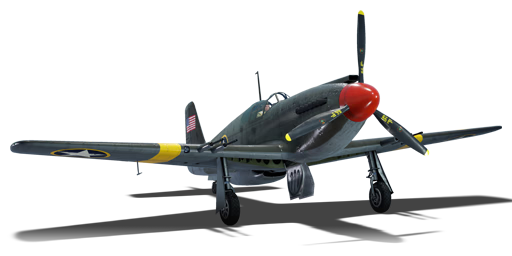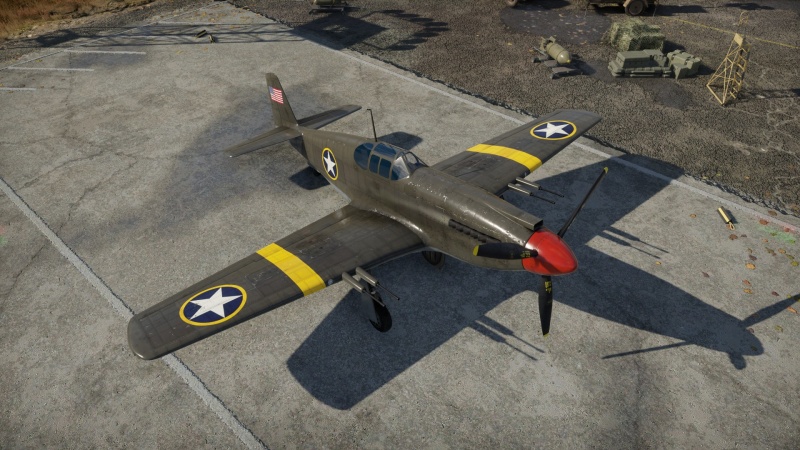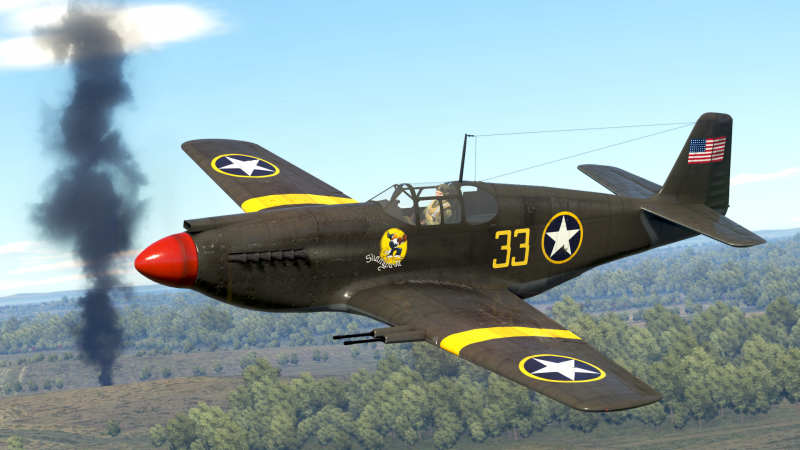P-51
| This page is about the American fighter P-51. For other versions, see P-51 (Family). |
Contents
Description
The P-51 Mustang is a rank American fighter with a battle rating of (AB), (RB), and (SB). It was introduced in Update 1.49 "Weapons of Victory".
The P-51 Mustang retains a lot of the traits that may be found in its later variants. The main difference comes from the limited Allison power plant and its formidable armament of 4 x 20 mm Hispano Mk.II cannons. The plane may not climb very well but does retain the traits of an energy fighter. Even with its limited climb rate the aircraft's dive-speed is excellent, but manoeuvrability is average at best. The armament is the true advantage of this aircraft. The 20 mm cannons are powerful, but with only 500 rounds do not try to go for more than what the P-51 can handle. The best way to use the P-51 is for Boom & Zoom.
The P-51, when fully upgraded, is an extremely deadly opponent, especially as a rank III. The engine will have a hard time hitting the "overheated" mark, even when using WEP. Use caution though, as the engine will retain its heat when constantly on 100% power, so it takes a bit to cool down. Also be sure to utilise the flaps: they are a major asset to the plane's overall turnfighting ability and sometimes allow it to survive a turn-fight with Soviet aircraft. This is an awesome plane for those just starting out in Realistic Battles, as the 20 mm cannons are good at scoring quick victories.
General info
Flight performance
"The Need for Speed" is a worthy credo for all Mustangs. This initial iteration boasts a significant speed advantage over many Rank III aircraft, but sacrifices are obvious. On the upside, the good maximum velocity greatly benefits the energy retention coming out of dives and for staying out of trouble.
Manoeuvrability is nothing to write home about (except roll-rate), especially without speed to burn. The control surfaces lock up at high speeds which makes the Mustang a comparatively agile fighter when initiating combat, but this is quickly lost. Fortunately the combat flaps have a very high speed tolerance and greatly benefit it in dogfights. Overall the P-51 likes to bleed speed in manoeuvres and the lost energy cannot be easily regained. For another downside is the sluggish acceleration which further causes a low rate of climb. Managing both disadvantage is the Ace's true skill for this elite Boom and Run fighter. However this is for an altitude range up to 4,000 m (13,000 ft). High altitude performance suffers which in combat, due the slow climb rate, is rarely reached anyway.
Thus all engagements, may they be Boom & Zoom or Boom & Run style, should be performed below said altitudes.
| Characteristics | Max speed (km/h at 5,200 m) |
Max altitude (metres) |
Turn time (seconds) |
Rate of climb (metres/second) |
Take-off run (metres) | |||
|---|---|---|---|---|---|---|---|---|
| AB | RB | AB | RB | AB | RB | |||
| Stock | 592 | 578 | 21.2 | 22.0 | 9.1 | 9.1 | 491 | |
| Upgraded | 673 | 631 | 18.8 | 20.0 | 18.6 | 13.1 | ||
Details
| Features | ||||
|---|---|---|---|---|
| Combat flaps | Take-off flaps | Landing flaps | Air brakes | Arrestor gear |
| ✓ | ✓ | ✓ | X | X |
| Limits | ||||||
|---|---|---|---|---|---|---|
| Wings (km/h) | Gear (km/h) | Flaps (km/h) | Max Static G | |||
| Combat | Take-off | Landing | + | - | ||
| 650 | 520 | 280 | ~12 | ~6 | ||
| Optimal velocities (km/h) | |||
|---|---|---|---|
| Ailerons | Rudder | Elevators | Radiator |
| < 500 | < 230 | < 550 | > 340 |
| Compressor | Optimal altitude | 100% Engine power | WEP Engine power |
|---|---|---|---|
| Setting 1 | 3,597 m | 1,150 hp | 1,598 hp |
Survivability and armour
- 19.05 mm Steel - Upper engine cowl armour plate
- 6.35 mm Steel - Fore cockpit armour plate
- 15.87 mm Steel - Armour plate behind pilot's seat
- 38 mm Bulletproof glass - Armoured windscreen
- Self-sealing fuel tanks (1 in each wing)
While the Mustang looks quite defensive on first glance, it is a deceptive one. The fuel tanks are wing-mounted and prone to fires (the D-series has got an inline one). The very small engine cowl plate could just as well be absent. Both issues combined leave many pilots a gliding and/or burning example of why to avoid bomber's defensive fire. The P-51's prime form of defense is speed. As a Boom & Run fighter, avoiding air-drag inducing bullet holes by not getting hit is a far preferable option anyway. Whilst setting up another attack (a.k.a. retreating from combat) the very generous backseat armour will absorb any stray shots. In general the pilot's survivability is great.
Modifications and economy
The P-51 Mustang can seem a very underwhelming aircraft at first. The primary module to focus on for early success is the 20 mm ammo belts. Ground targets belts will give more consistent results as an attacker and the Air targets belts can be devastating against flying opponents. After improving the firepower on the aircraft, begin focusing on performance upgrades.
Armaments
Offensive armament
The P-51 is armed with:
- 4 x 20 mm Hispano Mk.II cannons, wing-mounted (125 rpg = 500 total)
Quadruple Hispanos are devastating: pressing the trigger will significantly slow down the P-51. The airframe is too light, which further causes vibrations and heavy shaking due to the wing-mounted position of all arms. Hence the accuracy is appalling after the first shots leave the barrels. Trigger control is important, even more so as the Hispanos tend to overheat during long bursts. Continuous automatic fire will result in depleting your rounds in approximately 12.5 seconds (if the guns do not overheat and jam), and the reload time is quite long at 40 seconds. This incentivizes a boom and zoom playstyle.
Usage in battles
In an RPG the Mustang would be a rogue, the damage dealer. Quickly darting in and out of combat to deal devastating blows, the P-51 in War Thunder is a DPS main, too. Featured playstyles are Boom & Zoom, repeatedly diving on enemies and returning up high, and Boom & Run, flying into danger zone, picking of a target and retreating, all while running at top speed. Coupled with its manoeuvrability and acceleration deficits, the P-51 punishes any pilot who does not play to its strength, namely the top speed. Only late war or diving aircraft are able to catch a Mustang on the run and for the latter only with the correct timing and plenty of altitude to burn. Maintaining a cool head and areal observation are important. Retreating may look the cowardice choice, but with the speed to disengage many options open up for reversals. Note, do not perform flat turns, but rather slow, deliberate high Yo-Yos or Immelmanns for turning around. A careful approach when leading up for a shot helps in conserving precious momentum, too.
In Arcade Battles the option for in-air reloads may tempt the pilot to spray & pray and dump all the ammunition. However, with the inaccuracy issues and the short fire windows, a more deliberate approach is necessary. Waiting outside a furball or dogfight for the right moment to intercept is key, as the key role for the Mustang is heavy fire support. This is especially helpful against armoured attackers such as the Stuka or IL-2. Due to the lack of climb rate and poor altitude performance, bombers should not be sought out. In general the P-51 plays akin to many heavy fighters in Arcade mode.
In Realistic Battles the combat role is a tricky game. Lacking climb rate and high altitude performance the Mustang pilot needs to wait for the combat to come down to about 4,000 m (13,000 ft). Climbing should be done away from the expected combat zone (a.k.a. side-climbing) and at 20° with or 14° without WEP. At this point initial combat should be Boom & Run, utilizing the superior top speed to avoid combat while the enemy is focused on other team mates. Once the hostiles have dropped to a lower altitude Boom & Zooming can be engaged in. With 125 rounds per gun the fighter has got plenty of ammo to kill about six aircraft and with 30 min of fuel minimum, returning to base will be a rare occurrence. Overall this is a support fighter as in the current climbing meta engagements against higher flying interceptor-fighters are often deadly, as the Mustang then lacks the critical ability to choose the time of engagement.
Simulator Battles is where the P-51 (NA-91) truly shines. Flying at top speed with military rated power (100%) keeps the engine cool and enemies usually far away at one's tail. Most of all combat happens slightly below the Mustang's preferred altitude and the cockpit view is great, albeit with limited rearward view. Without the instructor the manoeuvrability markedly improves in comparison, for the P-51 has generous stall characteristics and is an overall stable gun platform, as long as one does not pull the trigger. Only the lack of acceleration in prolonged dogfights is a trap that even experienced pilots still fall into. An emergency dive to top speed will however fix this, if the pilot remembered to keep some altitude. And one should, for the greatest advantage is the ability to disengage any unfavourable battle and like with many things, the early Mustangs do not disappoint.
Manual Engine Control
| MEC elements | ||||||
|---|---|---|---|---|---|---|
| Mixer | Pitch | Radiator | Supercharger | Turbocharger | ||
| Oil | Water | Type | ||||
| Not controllable | Controllable Auto control available |
Not controllable Not auto controlled |
Controllable Auto control available |
Combined | Not controllable 1 gear |
Not controllable |
Pros and cons
Pros:
- Great flight performance
- Great dive-speed and acceleration
- High energy retention
- Good performance at high speeds
- Good roll rate
- Powerful armament
- Gains access to British belt load-outs, incl. the devastating air-targets belt
- Very efficient at destroying bombers
- 20 mm guns on the Mustang are mounted in close proximity, dealing a deadly double punch when hitting
- Can easily tackle higher BR foes
- Can be very deadly in the hands of a skilled pilot
Cons:
- Mediocre climb rate
- Low maximum altitude
- No separate gun control
- No payload options available
- Firing guns slows the plane down
- Poor visibility in simulator mode
- Hispano cannons overheat extremely quickly and are inaccurate unless upgraded
- Low ammo capacity compared to machine gun-armed variants
- Priority target when in AB mode due to its reputation of destroying planes with relative ease, smart players will try to eliminate the P-51 first.
- Minimal elevator authority without the engine producing net thrust as the plane relies heavily on streamline effect along the tail for elevator authority. Aircraft should not be landed with flaps down without an engine.
History
The North American P-51 was born when the British Government showed interest in purchasing the Curtiss P-40C. Curtiss was at max production capacity, so the British inquired to North American Aviation if they would build it under license for them. North American agreed, but they wanted to build a better aircraft. A condition of the sale from North American to the British was to supply the U.S. Army with two samples free of charge. The original prototypes were designated XP-51. The U.S. Army was given fourth and tenth aircraft. One of them can still be found at the EAA Museum in OshKosh, Wisconsin. Testing of the two prototypes started in October of 1941. The new aircraft received high marks and were clearly superior to other U.S. fighters at that time. Although, the U.S. Army decided to not immediately place orders.
The first order of Mustangs to the British were designated Mustang I. The RAF received these aircraft behind schedule in October of 1941. Problems showed up immediately including the Allison power-plant and other design flaws. It is also important to note the Mustang Mk I's armament consisting of four .30 cal machine guns mounted in the wings, as well as a set of two .50 Cal mounted in the wings and two .50 Cal machine guns mounted in the nose.
The next evolution of this aircraft was designated Mustang Mk IA. Due to the recently signed Lend Lease Act the U.S. Army was able to place an order for 150 more Mustangs on behalf of the British. These aircraft were equipped with four 20 mm Hispano Mk.II cannons mounted in the wings. Only 93 of the new Mustangs made it to the RAF. The U.S. Army pulled 55 for themselves and they immediately saw service. Two were kept by North American Aviation for internal use.
These P-51 Mustangs first saw service in April 9th of 1943 and the first combat loss came shortly afterwards on April 23rd. Mustangs saw action against the Japanese in the Aleutian Islands but a majority of them found their way to the Mediterranean theatre. The Mustang saw combat early on in the country of Algeria. Over time these P-51 Mustangs were converted to Reconnaissance planes. A K-24 camera was placed in the left window behind the pilot. The camera faced towards the back and down and took pictures providing battlefield reconnaissance. These aircraft saw continued service until the later part of 1944 continuing to fill the Attacker and Recon role.
Media
- Skins
- Videos
See also
- Related development
- North American P-51 Mustang
- P-51A Thunder League Event vehicle, version armed with 0.50 cal Browning MGs (12.7 mm)
- Mustang Mk IA for Great Britain, better horse power due higher manifold pressure
- A-36 Attacker variant, with bomb pylons and six 0.50 cal MGs
- P-51C-10
- Aircraft of comparable role, configuration and era
External links
- Official data sheet - more details about the performance
- [Wikipedia] P-51 (NA-91)
- [wwiiaircraftperformance.org] P-51 Mustang (Allison Engine) Performance Trials
| North American Aviation | |
|---|---|
| Fighters | |
| P-51A | P-51 · P-51A |
| P-51C | P-51C-10 |
| P-51D | P-51D-5 · P-51D-10 · P-51D-20-NA · P-51D-30 |
| P-51H | P-51H-5-NA |
| Twin-engine fighters | F-82E |
| Jet fighters | F-86A-5 · F-86F-2 · F-86F-25 · F-86F-35 · F-100D |
| Strike aircraft | A-36 · PBJ-1H · PBJ-1J |
| FJ-4B · FJ-4B VMF-232 | |
| Bombers | B-25J-1 · B-25J-20 |
| Export/Licence | ▂B-25J-30 · ␗B-25J-30 |
| ▄Mustang Mk IA · F-6C-10-NA · ␗P-51C-11-NT · ␗P-51D-20 · J26 David · J26 · P-51D-20-NA · ␗P-51K | |
| F-86F-30 ▅ · ␗F-86F-30 · F-86F-40 ▅ · F-86F-40 JASDF▅ · ␗F-86F-40 | |
| ◄F-86K · ▄F-86K (Italy) · ▄F-86K (France) | |
| ␗F-100A · ▄F-100D · ␗F-100F | |
| Captured | ▅P-51C-11-NT |
| Canadair Limited license-built the F-86 as the CL-13 for use in Canada and export to Europe. | |
| Fiat license-built the F-86K for the Italian Air Force though another 120 NAA built F-86Ks were also sold to the Italians. | |
| See Also | Mitsubishi Heavy Industries · Canadair Limited · Fiat Aviation |
| USA fighters | |
|---|---|
| P-26 Peashooter | P-26A-33 · P-26A-34 · P-26A-34 M2 · P-26B-35 |
| P-36 Hawk | P-36A · Rasmussen's P-36A · P-36C · ○P-36C · P-36G |
| P-39 Airacobra | P-400 · P-39N-0 · P-39Q-5 |
| P-40 | P-40C · P-40E-1 · P-40E-1 TD · P-40F-10 |
| P-43 Lancer | P-43A-1 |
| P-47 Thunderbolt | P-47D-22-RE · P-47D-25 · P-47D-28 · P-47M-1-RE · ⋠P-47M-1-RE · P-47N-15 |
| P-51 Mustang | P-51 · P-51A (Thunder League) · P-51C-10 · P-51D-5 · P-51D-10 · P-51D-20-NA · P-51D-30 · P-51H-5-NA |
| P-63 Kingcobra | P-63A-5 · P-63A-10 · P-63C-5 · ␠Kingcobra |
| Prototypes | XP-55 |
| F2A Buffalo | F2A-1 · Thach's F2A-1 · F2A-3 |
| BF2C | BF2C-1 |
| F3F | F3F-2 · Galer's F3F-2 |
| F4F Wildcat | F4F-3 · F4F-4 |
| F4U Corsair | F4U-1A · F4U-1A (USMC) · F4U-1D · F4U-1C · F4U-4 · F4U-4B · F4U-4B VMF-214 · F2G-1 |
| F6F Hellcat | F6F-5 · F6F-5N |
| F8F Bearcat | F8F-1 · F8F-1B |
| Other countries | ▃Ki-43-II · ▃Ki-61-Ib · ▃A6M2 · ▃Bf 109 F-4 · ▃Fw 190 A-8 · ▃Spitfire LF Mk IXc |






